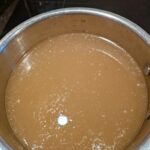Rich Chicken Broth
Yield: 1.5 liters
Materials
- 2 chicken leg quarters
- 0.5 leftover chicken carcass meat removed
- 2 liters water
- 1 teaspoon salt
- Reserved drippings from roast chicken (optional)
Instructions
- Place the chicken pieces into at least a 3L pot. Cover with 2L water and add salt.
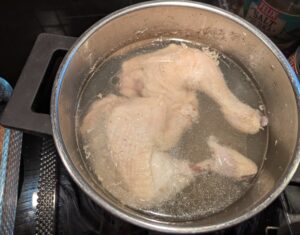
- Here, I just used a couple of leg quarters straight from the freezer, but feel free to use the equivalent in other bone-in chicken parts, or half a chicken. (This is a small batch, but it scales up readily.) At least some dark meat pieces will give you better broth.The existing carcass is also optional, but any extra bones and connective tissue you have will also help make your broth richer.
- Bring to a boil, and skim the foam from the surface with a spoon.
- Turn down the heat, and simmer covered for an hour. I like to gently stir and flip pieces like this over about halfway through cooking, to make sure it cooks as evenly as possible. This may not be necessary, depending on what you're using.
- Once it has simmered for an hour, carefully pull out the chicken with a slotted utensil. Reserve to the side in a dish, to cool enough to handle.
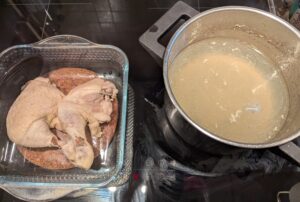
- While your pieces cool, take the reserved carcass and add it to the pot. Cover and continue to simmer.
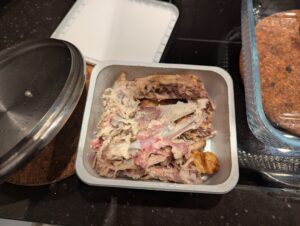
- Once the chicken is cool enough not to burn yourself trying to dismantle it, carefully drain any liquid which has collected in the pan back into the pot. Pull the meat off the bones, and set it to one side. I like to hold onto it with one hand, and pull at the meat with a fork.Slide the skin, bones, and any gristle back into the simmering pot.
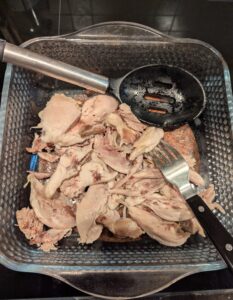
- Cover and continue to simmer all of the chicken bones and scraps for another hour.
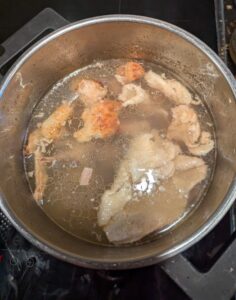
- Optional: Add the reserved jellied gold of your reserved roast chicken drippings into the broth pot if you have any, and let simmer another 15 minutes. We will deal with the chicken fat later.
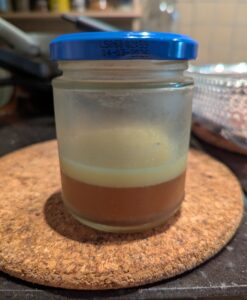
- Pour the finished broth through a mesh strainer, into another pot of at least 2L cooking capacity.Let the carcass drain any remaining liquid for a few minutes, before discarding. In this case, the liquid level came up high enough that I needed to let it drip into the original cooking pot and pour the proceeds back over from there.
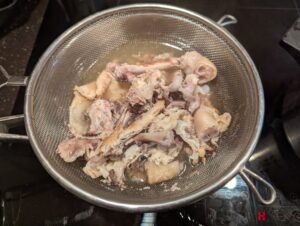
- Finished broth! This gave me around 1.5L in the end, but I did not measure the water going in precisely. I just eyeballed "a couple of liters/quarts". You may get more or less from a starting 2L after the cooking evaporation, etc. It's all good.
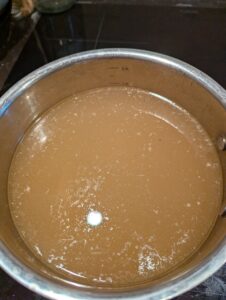
- Use immediately, or reserve for later. We'll cover that next.
Saving For Later
- If you want more concentrated broth to freeze, let it boil down over medium heat until you have around a liter left. We will also deal with the excess fat after this.(I did not reduce it in this case, because it was already concentrated enough for me--and I chose just to reserve a liter for later use as-is.)
- To do this fairly easily, pour the broth you want to save into a container like a Pyrex measuring cup.Let cool enough, and refrigerate at least overnight covered.
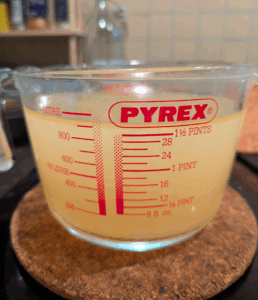
- Your broth should have gelled, and the fat separated out into a solid layer on top. (I haven't gotten that far yet, writing this up.)You can carefully scrape off the chicken fat into a small jar, and save in the refrigerator to use for cooking later if you like. Try not to get broth in there. I don't mind if a little fat stays with the broth.
- Reheat the broth until it becomes liquid again. A couple of minutes in the microwave is perfect for this.Freeze in containers or Ziploc bags of the size you prefer. You may want to label them to remind yourself that it should be used 1:1 with water, if you did go for the condensed broth approach. I will usually go in increments of around 1 cup/250ml.
- For more flexibility when you go to use your broth, Chinese Cooking Demystified demonstrated in one excellent recent video how to freeze it in convenient ice cube bags. You can of course also just use an ice tray.
